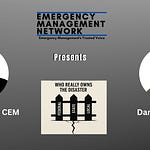
Natural and technological hazards are a fact of life, and disasters can strike anytime. The frequency and severity of these events are on the rise, and they can cause significant loss of life, property damage, and economic disruption. In recent years, we have seen hurricanes, wildfires, earthquakes, floods, and other disasters affect communities around the world. While focusing on local loss reduction is essential, it is time to adopt a broader approach that considers the global context of these hazards, environmental sustainability, and social resiliency.
The current approach to hazard mitigation focuses on reducing the immediate risks and losses within a particular community or region. However, this approach is often ineffective because it fails to consider the broader context of the hazard. For example, when a hurricane strikes a coastal town, the immediate response may be evacuating residents, securing buildings, and preparing for flooding. While these measures are essential, they do not address the underlying causes of hurricanes, such as climate change, deforestation, or ocean warming. Similarly, when an earthquake hits a city, the immediate response may be to search for survivors, treat the injured, and repair damaged infrastructure. However, these efforts do not address the underlying causes of the earthquake damage, such as land use practices or geological instability where homes are built.
To address these underlying causes, we need to adopt a revised framework linking natural hazards to their global context, environmental sustainability, and social resiliency. This new approach would consider the complex interconnections between natural hazards and the environment, economy, and society. It aims to reduce the vulnerability of communities to these hazards by addressing the root causes of the problem rather than just the symptoms. It would recognize that natural hazards are not just local problems but global challenges that require a coordinated and collaborative response.
The first step in this revised framework is to link natural hazards to their global context. When natural hazards become disasters, they are not isolated events but are often part of more extensive environmental processes. For example, hurricanes are often fueled by warm ocean waters, which are affected by global warming. Similarly, wildfires are often the result of a combination of factors, including drought, land use practices, and climate change. By linking natural hazards to their global context, we can better understand the underlying causes of these events and take steps to address them.
The second step in this revised framework is to link natural hazard mitigation to environmental sustainability. Hazards are often the result of environmental degradation, such as deforestation, soil erosion, or air pollution. Promoting environmental sustainability can reduce the likelihood and severity of the impact of natural disasters. For example, reforestation can help prevent soil erosion and landslides, common after heavy rains. Similarly, reducing greenhouse gas emissions can help mitigate the impacts of climate change, which is causing more frequent and severe natural disasters.
This revised framework's third step is linking natural hazards to social resiliency. Social resiliency refers to a community's ability to cope with and recover from natural disasters. Promoting social resiliency can reduce the impact of disasters on people's lives and livelihoods. For example, building more resilient infrastructure, such as storm shelters or earthquake-resistant buildings, can help communities better withstand natural disasters. Similarly, helping individuals and families cope with the aftermath of a natural disaster.
To make this revised framework a reality, we need to modify hazard mitigation efforts to be compatible with this new vision. We must shift our focus from short-term, reactive measures to long-term, proactive solutions. We must invest in research and development to better understand the underlying causes of natural hazards and develop effective strategies for reducing their impact. We must collaborate across sectors and borders to address the global nature of disasters. And we need to prioritize the needs and perspectives of vulnerable communities, such as low-income populations, indigenous groups, and marginalized communities, who are often disproportionately affected by natural hazards.
One way to modify hazard mitigation efforts is to adopt a more holistic and integrated approach to disaster risk reduction. This approach recognizes that natural hazards are just one aspect of a complex and interconnected system, including social, economic, and environmental factors. It seeks to address the root causes of disaster risk, such as poverty, inequality, and environmental degradation, and to build resilience at all levels of society. It also recognizes that disaster risk reduction is a continuous process that requires ongoing efforts and collaboration.
Another way to modify hazard mitigation efforts is to embrace new technologies and innovative solutions. Technology can play a critical role in mitigating the impact of natural hazards by providing early warning systems, improving communication and coordination among responders, and enhancing the resilience of infrastructure and buildings. For example, remote sensing and satellite imagery can help predict the path and intensity of hurricanes. In contrast, artificial intelligence and machine learning can help identify vulnerable communities and prioritize response efforts. Similarly, new materials and construction techniques can help create buildings and infrastructure more resilient to natural disasters.
Finally, we must modify hazard mitigation efforts by engaging with diverse stakeholders and promoting public participation. Natural hazards affect everyone, and everyone has a stake in reducing their impact. By involving various stakeholders, including government agencies, private sector actors, civil society organizations, and community members, we can build a more comprehensive and effective approach to hazard mitigation. We can also promote public participation by providing information, education, and outreach to help people better understand the risks and take steps to reduce their vulnerability.
It is time for a nationwide evolutionary shift in coping with natural and technological hazards by universally adopting goals broader than local loss reduction. This requires a revised framework that links natural hazards to their global context, environmental sustainability, social resiliency, and modified hazard mitigation efforts compatible with that new vision. By adopting a more holistic and integrated approach, embracing new technologies and innovative solutions, engaging with diverse stakeholders and promoting public participation, we can build a more resilient and sustainable future for all.
Here is a checklist that will help you develop your holistic approach.
Develop a comprehensive emergency management plan that incorporates the principles of holistic emergency management, including a focus on linking natural hazards to their global context, environmental sustainability, and social resilience.
Conduct a hazard assessment that considers the potential impact of natural and technological hazards on the community and the environment.
Engage stakeholders and the community in the emergency management planning process to ensure that the whole community is involved in the planning and implementing of emergency management activities.
Establish partnerships with other organizations and agencies to ensure a coordinated approach to emergency management.
Establish a plan to ensure effective communication with all stakeholders during an emergency.
Develop and maintain a system for collecting and analyzing data to inform decision-making and improve emergency management processes.
Conduct regular training and exercises to ensure emergency management personnel and stakeholders are prepared to respond to emergencies effectively.
Develop and implement strategies to promote environmental sustainability and social resilience in the community.
Monitor and evaluate the effectiveness of the emergency management program regularly and make necessary adjustments to improve performance.
It's important to note that the specific steps and activities required to implement holistic emergency management will depend on the unique needs and characteristics of the community and the potential hazards it faces. The checklist above should be a general guide rather than an exhaustive list of actions.











